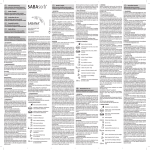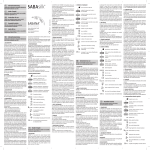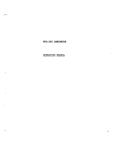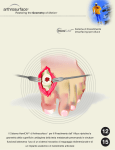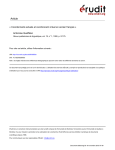Download © Mode d`emploi GB Instructions for use H Használati utasítás
Transcript
D Il est disponible dans différentes grosseurs et longueurs de fil avec des aiguilles chirurgicales fixement armées de types et de diamètres différents. L’emballage de SABAguard® est vert. SABAguard® remplit les exigences sévères de la pharma copée européenne et de la directive CE 93/42/CEE concer nant les dispositifs médicaux. Gebrauchsanweisung Steriles nicht-resorbierbares chirurgisches Nahtmaterial Nadel-Faden-Kombination aus Polyester F Mode d’emploi Matériel de suture chirurgical stérile non-résorbable Combinaison aiguille-fil en polyester Instructions for use Materiale di sutura chirurgico sterile non riassorbibile Combinazione ago-filo in poliestere D Gebrauchsanweisung Steriles nicht-resorbierbares chirurgisches Nahtmaterial Nadel-Faden-Kombination aus Polyester 1. BESCHREIBUNG SABAguard ist ein synthetisches nicht-resorbierbares steri les geflochtenes beschichtetes oder unbeschichtetes chirur gisches Nahtmaterial, das durch Polymerisation durch Polykondensation von Ethylenglykol und Terephthalsäure hergestellt wird. Polyester bietet eine sehr gute Gewebe verträglichkeit und bewahrt sehr lange seine Initialzugfestig keit. Die Oberflächenstruktur lässt einen besonders guten Knotensitz zu. SABAguard® Nahtmaterial ist ungefärbt oder mit physio logisch unbedenklichem Farbstoff grün oder schwarz ein gefärbt lieferbar. Es ist in verschiedenen Fadenstärken und -längen mit fest armierten chirurgischen Nadeln unterschiedlicher Typen und Durchmesser erhältlich. Die Verpackung von SABAguard® ist grün gekennzeichnet. SABAguard® erfüllt die strengen Anforderungen des Europäischen Arzneimittelbuchs und der EG-Richtlinie 93/42/EWG über Medizinprodukte. ® 2. ANWENDUNGSGEBIETE SABAguard® ist vorgesehen für die Anwendung in der all gemeinen Chirurgie, der Gynäkologie und der Oralchirurgie. Stand: 03/2012 Sabana Medizinbedarf GmbH Alwinenstraße 2 65189 Wiesbaden/Germany www.sabana.de Vorsicht auch vor Nadelstichverletzungen! Gebrauchte Nadeln sind sofort nach der Benutzung in einen geeigneten durch stichsicheren Behälter zu entsorgen. 5. NEBENWIRKUNGEN Unerwünschte Nebenwirkungen bei der Anwendung von SABAguard® können als anfängliche entzündliche Gewebe reaktion oder als vorübergehende Irritation in der Wund region auftreten. Wie alle Fremdkörper kann das Nahtmate rial eine vorhandene Infektion verstärken. 6. STERILITÄT SABAguard® Nadel-Faden-Kombinationen sind mit Ethylenoxid sterilisiert. Es ist nicht zulässig, SABAguard® zu resterilisieren! Das Produkt darf keinesfalls verwendet werden, wenn die Sterilverpackung beschädigt oder geöffnet ist. Geöffnete, nicht benutzte Produkte unbedingt entsorgen. 7. LAGERBEDINGUNGEN SABAguard® darf nur unter normalen Umgebungsbedingungen und geschützt vor Feuchtigkeit und direkter Hitzeeinwirkung gelagert werden. Nur in der Originalverpackung aufbewahren. Nach Ablauf des Verfallsdatums nicht mehr verwenden. 8. KENNZEICHNUNGSSYMBOLE Name und Anschrift des Herstellers Anwendung Das zu verwendende Nahtmaterial ist unter Berücksichtigung des Zustands des Patienten und der Größe der Wunde aus zuwählen. gefärbtes, geflochtenes, nicht-resorbierbares Nahtmaterial ungefärbtes, geflochtenes, nicht-resorbierbares Nahtmaterial Materialverhalten SABAguard® löst eine anfängliche minimale entzündliche Ge webereaktion aus, worauf eine schrittweise Umschließung durch faseriges Bindegewebe eintritt. gefärbtes, geflochtenes, beschichtetes und nicht-resorbierbares Nahtmaterial 3. GEGENANZEIGEN ungefärbtes, geflochtenes, beschichtetes und nicht-resorbierbares Nahtmaterial SABAguard® ist nicht bestimmt für Anwendung am Herz, am zentralen Kreislaufsystem oder am zentralen Nervensystem. Es sollte nicht bei Patienten mit bekannter Überempfind lichkeit oder allergischer Reaktion gegen Polyester verwendet werden. SABAguard® sollte nicht eingesetzt werden, wenn eine Erhaltung der Reißfestigkeit des Nahtmaterials erfor derlich ist, da diese über einen längeren Zeitraum in vivo nachlassen kann. Chargenbezeichnung Sterilisiert mit Ethylenoxid Nicht zur Wiederverwendung Nicht erneut sterilisieren 4. WARNHINWEISE SABAguard® ist zum einmaligen Gebrauch bestimmt. Die Na deln dürfen keinesfalls resterilisiert werden. Die erneute Ver wendung kann zu schweren, unter Umständen sogar tödlichen Infektionen des Patienten führen. Entsprechend den gesetz lichen Bestimmungen übernimmt der Hersteller hierfür keine Verantwortung. SABAguard® darf nicht verwendet werden, • wenn das Verfallsdatum überschritten ist, • die Sterilverpackung beschädigt ist oder • Zweifel an ihrer Unversehrtheit bestehen. SABAguard® darf nur von Ärzten angewendet werden, die mit der Anwendung von nicht-resorbierbarem Nahtmaterial vertraut sind, da das Risiko einer Wunddehiszenz vom Anwen dungsort und vom verwendeten Nahtmaterial abhängt. Da rüber hinaus muss der Operateur auch über ausreichende Kennt nisse über das notwendige Handling (z. B. Knotentechniken) verfügen. Der Operateur ist für Komplikationen verantwort lich, die sich aus einer fehlerhaften Indikation, einer unzurei chenden Operationstechnik oder einem aseptischen Fehler ergeben. In allen Fällen wird empfohlen, den Eingriff durch entsprechende Nachsorgemaßnahmen zu begleiten. Wie jeder Fremdkörper kann ein längerer Kontakt mit Salz lösungen, wie sie etwa im Gallentrakt vorkommen, zur Bil dung von Konkrementen führen. Wie bei jedem anderen Nahtmaterial ist auch bei SABAguard® darauf zu achten, dass es nicht durch falsche Handhabung be schädigt wird. So hinterlässt das Fassen mit einem Nadelhalter oder einer Klemme deutliche Spuren am Faden. Diese Schä digungen nehmen großen Einfluss auf die Reißfestigkeit eines Fadens. Auch die Handhabung der Nadel darf nur mit angemessener Vorsicht erfolgen. Die Nadel sollte immer am Anfang des letzten Drittels gefasst werden. Das Fassen der Nadel im Nadelspitzenbereich kann die Penetrationswirkung beein trächtigen und zum Bruch der Nadel führen. Gleiches gilt für das Fassen der Nadel am armierten Ende. 0123 Használati utasítás Guida all’uso matériel de suture teinté, tressé, non-résorbable matériel de suture non-teinté, tressé, non-résorbable SABAguard® est prévu pour une utilisation en chirurgie générale, en gynécologie et en chirurgie orale. Steril nem felszívódó sebészeti varróanyag Tű-fonal kombináció poliészter alapanyagból I Nom et adresse du fabricant 2. DOMAINES D’UTILISATION Sterile, non-absorbable surgical suture material Needle-suture combination made of polyester H 8. SYMBOLES DE MARQUAGE Gebrauchsanweisung beachten J J JJ-MM Verwendbar bis (Jahr-Monat) Vor Sonnenlicht geschützt aufbewahren Obere Temperaturbegrenzung für die Lagerung Bei beschädigter Verpackung nicht verwenden 0123 CE-Kennzeichnung mit Kennnummer der Benannten Stelle F Mode d’emploi Matériel de suture chirurgical stérile non-résorbable Combinaison aiguille-fil en polyester 1. DESCRIPTION SABAguard® est un matériel de suture chirurgical synthétique stérile tressé non-résorbable enduit ou non-enduit, fabriqué par polycondensation d’éthylène glycol et d’acide téréphta lique. Le polyester présente une très bonne tolérance des tissus et conserve très longtemps sa résistance initiale à la traction. La structure de la surface permet une tenue parti culièrement bonne du nœud. Le matériel de suture SABAguard® est disponible sous forme non colorée, ou teint avec des colorants verts ou noir inoffensifs au niveau physiologique. matériel de suture teinté, tressé, enduit et non-résorbable UTILISATION Le matériel de suture à utiliser doit être choisi en fonction de l’état du patient et de la taille de la plaie. matériel de suture non-teinté, tressé, enduit et non-résorbable COMPORTEMENT DU MATERIAU SABAguard® déclenche une réaction inflammatoire initiale minime du tissu, suivie d’un enrobage progressif par du tissu conjonctif fibreux. désignation du lot stérilisé à l’oxyde d’éthylène 3. CONTRE-INDICATIONS SABAguard® n’est pas fait pour une utilisation sur le cœur, l’appareil circulatoire central ou le système nerveux central. Il ne faut pas l’utiliser chez des patients présentant une hypersensibilité connue ou une réaction allergique au po lyester. Quand le maintien de la résistance à la rupture du matériel de suture est nécessaire, il ne faut pas utiliser SABAguard® car au bout d’une période assez longue in vivo, la résistance peut relâcher. ne pas réutiliser ne pas stériliser à nouveau tenir compte du mode d’emploi JJJ J-MM à utiliser d’ici (année-mois) conserver à l’abri de la lumière du soleil 4. MISES EN GARDE PARTICULIÈRES SABAguard® est destiné à un usage unique. Il ne faut jamais restériliser les aiguilles. Une utilisation renouvelée peut entraîner de graves infections du patient, voire des infec tions mortelles. Conformément aux dispositions légales, le fabricant décline toute responsabilité à cet égard. Il ne faut pas utiliser SABAguard®, • quand la date de péremption est dépassée • quand l’emballage stérile est endommagé ou • s’il y a des doutes quant à l’intégralité de l’emballage. SABAguard® ne peut être utilisé que par des médecins qui connaissent bien l’utilisation de matériel de suture nonrésorbable, puisque le risque de déhiscence de plaie dépend de l’endroit de l’utilisation et du matériel de suture utilisé. En outre, le chirurgien doit disposer de connaissances suf fisantes sur la manipulation (p.ex. techniques de nœuds). Le chirurgien est responsable des complications résultant d’une indication erronée, d’une technique opératoire insuf fisante ou d’une erreur stérile. En tous cas, on recommande d’accompagner l’opération de mesures de suivi correspon dantes. Comme tout corps étranger, un contact prolongé avec des solutions salées – comme c’est le cas dans les voies biliai res, peut entraîner la formation de concrétions. Dans l’utilisation de SABAguard®, comme dans l’utilisation de tout autre matériel de suture, il faut également veiller à ne pas endommager le matériel par fausse manipulation. La saisie du fil avec un porte-aiguille ou une pince laisse des traces distinctes sur le fil. Ces dégradations ont une grande influence sur la résistance d’un fil à la rupture. Il faut également manier l’aiguille avec une précaution adéquate. C’est toujours uniquement au début du dernier tiers qu’il faut tenir l’aiguille. Quand on tient l’aiguille dans la zone de la pointe, cela peut altérer l’effet de pénétration et entraîner la rupture de l’aiguille. La même chose vaut pour la saisie de l’aiguille par le bout armé. Attention également aux blessures par piqûres d’aiguille! Après utilisation, il faut immédiatement éliminer les aiguilles usagées dans des contenants spéciaux destinés à recevoir des aiguilles et des objets pointus ou tranchants. 5. EFFETS SECONDAIRES température maximale de stockage 6. STERILITY SABAguard® needle and suture combinations are sterilized with ethylene oxide. Resterilization of SABAguard® is prohibited! The product must not be used if the sterile packaging is damaged or open. Always dispose of opened, unused products. 7. STORAGE CONDITIONS SABAguard® must be stored only at temperatures below 25° Celsius and protected from moisture and direct exposure to heat. Store only in the original packaging! Do not use this product after the expiration date! 8. LABELING SYMBOLS Manufacturer’s name and address Dyed, woven, non-absorbable suture material du service accrédité Undyed, woven, non-absorbable suture material Dyed, woven, coated and non-absorbable suture material Instructions for use Undyed, woven, coated and nonabsorbable suture material Sterile, non-absorbable surgical suture material Needle-suture combination made of polyester Batch designation 1. DESCRIPTION SABAguard® is a synthetic, non-absorbable, sterile, woven, coated or uncoated surgical suture material produced via condensation polymerization of ethylene glycol and terephtha lic acid. Polyester offers excellent tissue compatibility and maintains its initial tensile strength for a very long time. Its surface structure facilitates particularly firm, stable knotting. SABAguard® suture material is available undyed or dyed green or black with physiologically safe dye. It is available in different sizes and lengths with swaged surgical needles of various types and diameters. The packaging of SABAguard® is marked in green. SABAguard® meets the strict requirements of the European Pharmacopoeia and the EC Directive 93/42/EEC on medical devices. Sterilized with ethylene oxide Do not re-use. Do not resterilize. Comply with the instructions for use. JJJ J-MM Usable until (year-month) Store in a dark location away from sunlight. Upper temperature limit for storage 2. AREAS OF APPLICATION SABAguard is intended for use in general surgery, gyne cology and oral surgery. ® APPLICATION The suture material to be used must be selected based on the condition of the patient and the size of the wound. 6. STÉRILITÉ Les combinaisons d’aiguille et de fil SABAguard® sont sté rilisées à l’oxyde d’éthylène. Il est interdit de restériliser SABAguard®! Le produit ne peut en aucun cas être utilisé si l’emballage stérile est endommagé ou ouvert. Il faut absolument éliminer les produits ouverts non utilisés. SABAguard® is not intended for use in the heart, the central cardiovascular system or the central nervous system. It should not be used in patients with known sensitivities or allergies to polyester. SABAguard® should not be used when preservation of the stability of the suture material is required, as this can deteriorate over a longer period in vivo. 7. CONDITIONS DE STOCKAGE 4. WARNINGS SABAguard doit être uniquement stocké dans des condi tions ambiantes normales et il faut le protéger de l’humi dité et de l’effet direct de la chaleur. A conserver uniquement dans l’emballage original. Ne plus utiliser après expiration de la date de péremption. Adverse side effects from the use of SABAguard® can consist of temporary tissue irritation or a temporary inflammatory reaction in the area of the wound. Like all foreign bodies, the suture material can aggravate an existing infection. 0123 marquage CE avec numéro d’indentification MATERIAL BEHAVIOR ® 5. SIDE EFFECTS ne pas utiliser en cas d’emballage endommagé Dans l’utilisation de SABAguard , les effets secondaires non souhaités peuvent consister en une réaction initiale d’in flammation du tissu ou en une irritation passagère dans la zone de la plaie. Comme tous les corps étranger, le matériel de suture peut aggraver une infection existante. ® SABAguard® to ensure that it is not damaged by incorrect handling. Thus, gripping it with a needle holder or a clamp leaves clear marks on the suture. Such damage has a strong influence on the stability of a suture. The needle must also be handled with the appropriate care. The needle should always be grasped at the beginning of the last third. Grasping the needle at its point can impair penetration and result in breakage of the needle. The same applies to grasping the needle at the swaged end. Caution must also be exercised with regard to puncture injuries from needles. Used needles must be disposed of in a suitable puncture-proof container immediately after use. SABAguard® triggers an initial minimally inflammatory tissue response, followed by incremental envelopment in fibrous connective tissue. 3. CONTRAINDICATIONS SABAguard® is intended for single use only. The needles may not be resterilized under any circumstances. Re-use can lead to severe and possibly fatal infections in patients. In accordance with statutory provisions, the manufacturer is not liable for this. SABAguard® may not be used • if the expiration date is in the past, • the sterile packaging is damaged or • there is doubt as to whether it is intact. SABAguard® may be used only by physicians who are familiar with the use of non-absorbable suture material, as the risk of wound dehiscence depends on the site where the sutu res are used and on the suture material used. In addition, the surgeon must have sufficient knowledge of the handling required (e.g. knotting techniques). The surgeon is respon sible for complications resulting from an incorrect indica tion, inadequate surgical techniques or an aseptic error. In all cases it is recommended that the surgery be accompanied by corresponding after-care measures. Like any foreign body, longer contact with saline solutions such as those in the urinary and biliary tracts, can result in the formation of concrements. As with any other suture material, care must be taken with Do not use if the packaging is damaged. 0123 CE mark with code number of the Notified Body 3. ELLENJAVALLATOK A SABAguard® nem alkalmazható a szíven, a központi ke ringési rendszeren és a központi idegrendszeren végzett beavatkozások során. A poliészterrel szemben ismert túlérzékenyéséggel rendel kező vagy arra allergiásan reagáló betegek esetén alkal mazása ellenjavallt. Mivel hosszabb idő elteltével a SABA guard® szakítószilárdsága in vivo csökkenhet, alkalmazása ellenjavallt minden olyan esetben, ahol a varróanyag sza kítószilárdsága változatlan kell legyen. 4. FIGYELMEZTETÉSEK A SABAguard® egyszeri használatra szánt termék. A tűket tilos újrasterilizálni. Ezek újrafelhasználása súlyos, egyes esetekben akár halálos fertőzést is eredményezhet a be tegben. A törvényes rendelkezések értelmében a gyártó ilyen esetekben nem vállal felelősséget. A SABAguard® nem alkalmazható, ha • lejárt a felhasználási ideje, • nem ép a steril csomagolás vagy • kétség merül fel a csomagolás sértetlenségét illetően. A SABAguard®-ot csak a nem felszívódó varróanyagok al kalmazásában jártas orvosok használhatják, mert a varra telégtelenség kockázatának fellépése az alkalmazás helyétől és az alkalmazásra kerülő varróanyagtól függ. A sebésznek emellett megfelelő ismeretekkel kell rendelkeznie a sebés zeti eljárások terén (pl. csomózási technikák). A helytelen indikációból, a nem megfelelő sebészeti technika alkalma zásából és az aszepszist gátló hibákból eredő szövődményekért a sebész a felelős. Minden egyes beavatkozás után tanác sos megfelelő utógondozásban részesíteni a beteget. A varrófonalak tartós érintkezése idegen anyaggal, így pl. az epeutak területén előforduló sóoldatokkal is, kőképződéshez vezethet. Mint minden egyéb varróanyagnál, úgy a SABAguard® esetén is ügyelni kell arra, hogy az anyag ne károsodjon helytelen kezelés következtében. Ha a tűfogó vagy a csi pesz érintkezik a fonallal, maradandó nyomot hagy hátra. Ezek a károsodások jelentősen befolyásolják a fonal szakí tószilárdságát. A tűt is csak kellő óvatosság mellett szabad alkalmazni, és mindig az utolsó harmad kezdeténél kell megfogni. A tűhegy területének megragadása a penetrációs képesség csökke nését és a tű eltörését eredményezheti. Ugyanez történhet a tű fonalhoz csatlakozó végének megragadásakor is. Óvatosan kell eljárni a tűszúrás okozta sérülések elkerülése érdekében is. A használt tűt az alkalmazást követően hala déktalanul egy erre a célra alkalmas szúrásbiztos tartályba kell bedobni. 5. MELLÉKHATÁSOK A SABAguard® alkalmazása során fellépő nemkívánatos mellékhatások a következők lehetnek: kezdeti gyulladásos szövetreakció, a sebkörnyék átmeneti irritációja. Mint minden idegen test, így a varróanyag is súlyosbíthatja a már fennálló fertőzéseket. 6. STERILITÁS A SABAguard® tű-fonal kombináció sterilizálása etilén-oxiddal történik. A SABAguard® újrasterilizálása tilos. Ha a steril csomagolás nem ép vagy nyitva van, a terméket nem szabad alkalmazni. A nyitott állapotú, fel nem használt terméket mindenképpen ki kell dobni. 7. TÁROLÁSI FELTÉTELEK A SABAguard® csakis normál környezeti feltételek mellett, nedvességtől és közvetlen hőhatástól védve tárolandó. Kizárólag az eredeti csomagolásban tartandó. A felhasználhatósági idő lejárta után nem szabad alkalmazni. 8. A CSOMAGOLÁSON HASZNÁLT JELÖLÉSEK A gyártó neve és címe H Használati utasítás Steril nem felszívódó sebészeti varróanyag Tű-fonal kombináció poliészter alapanyagból színezett, fonott, nem felszívódó varróanyag 1. TERMÉKLEÍRÁS A SABAguard szintetikus, nem felszívódó, steril, fonott, be vonatos vagy bevonat nélküli sebészeti varróanyag, melyet etilén-glikol és tereftálsav polikondenzációjával állítanak elő. A poliészter kiváló szöveti kompatibilitással rendelkezik és igen sokáig megőrzi kezdeti szakítószilárdságát. Felszíni szerkezetének köszönhetően különösen jól csomózható. A SABAguard® varróanyag színtelen vagy fiziológiailag ártal matlan zöld vagy fekete színezékanyaggal színezett kiszere lésben kapható. Különböző fonalvastagságban és -hosszban, valamint kü lönböző típusú és átmérőjű, fixen a fonalhoz csatlakozó sebészeti tűvel felszerelve kerül forgalomba. A SABAguard® csomagolása zöld jelölést visel. A SABAguard® megfelel az Európai Gyógyszerkönyv és az orvostechnikai eszközökről szóló 93/42/EGK irányelv szigorú követelményeinek. ® 2. ALKALMAZÁSI TERÜLETEK A SABAguard® alkalmazása az általános sebészet, a nőgyógyászat és a szájsebészet területén javallott. ALKALMAZÁS színezetlen, fonott, nem felszívódó varróanyag színezett, fonott, bevonatos és nem felszívódó varróanyag színezetlen, fonott, bevonatos és nem felszívódó varróanyag Gyártási szám Etilén-oxiddal sterilizálva Egyszer használatos Nem szabad újrasterilizálni Vegye figyelembe a használati utasítást. JJJ J-MM Felhasználható: (év-hónap) Napfénytől védve tartandó. A alkalmazott varróanyag kiválasztásakor a beteg állapotát és a seb méretét kell figyelembe venni. Maximális tárolási hőmérséklet ANYAGVISELKEDÉS Nem szadad alkalmazni, ha a csomagolás nem ép. A SABAguard® kezdetben minimális gyulladásos szövetre akciót idéz elő, amit a varróanyag fokozatos kötőszövetes betokozódása kísér. 0123 CE-jelölés bevizsgálóhely azonosító számával I Guida all’uso Materiale di sutura chirurgico sterile non riassorbibile Combinazione ago-filo in poliestere 1. DESCRIZIONE SABAguard è un materiale di sutura chirurgico sintetico non riassorbibile sterile intrecciato rivestito o senza rivesti mento, ottenuto dalla policondensazione di etilenglicole e acido tereftalico. Il poliestere presenta un’ottima tollerabi lità tissutale e preserva a lungo la sua forza tensile iniziale. La struttura superficiale favorisce una tenuta particolarmente buona del nodo. Il materiale di sutura SABAguard® è fornito non colorato o colorato con colorante verde o nero fisiologicamente sicuro. È disponibile in fili di diverso spessore e lunghezza con aghi chirurgici saldamente armati di vario tipo e diametro. SABAguard® si riconosce dalla confezione in colore verde. SABAguard® soddisfa i severi requisiti della Farmacopea Europea e della direttiva comunitaria 93/42/CEE sui prodotti medicali. ® 2. CAMPO DI IMPIEGO SABAguard® è previsto per l’uso nella chirurgia generale, la ginecologia e la chirurgia orale. IMPIEGO Il materiale di sutura da utilizzare va scelto tenendo conto delle condizioni del paziente e delle dimensioni della ferita. COMPORTAMENTO DEL MATERIALE SABAguard® causa una minima reazione infiammatoria iniziale nei tessuti, seguita da un graduale incapsulamento della sutura nel tessuto connettivo fibroso. 3. CONTROINDICAZIONI SABAguard® non è destinato all’uso sul cuore, sul sistema circolatorio centrale o sul sistema nervoso centrale. È controindicato in pazienti con una nota ipersensibilità o una nota manifestazione allergica al poliestere. SABAguard® non andrebbe impiegato quando sia necessario conservare la resistenza allo strappo del materiale di sutura, potendo questa attenuarsi in vivo su un prolungato arco di tempo. 4. AVVERTENZE SABAguard® è destinato a essere usato una volta sola. Gli aghi non devono essere risterilizzati in nessun caso. Il riuti lizzo può portare a gravi infezioni nel paziente, persino letali in alcune circostanze. Conformemente alle disposizioni di legge, il produttore non assume alcuna responsabilità a questo riguardo. SABAguard® non deve essere utilizzato quando: • si è superata la data di scadenza, • la confezione sterile è lesionata oppure • ci sono dubbi sulla sua integrità. SABAguard® può essere impiegato solo da medici che hanno confidenza con l’utilizzo di materiale di sutura non riassor bibile, in quanto il rischio di una deiscenza della ferita dipende dal punto di applicazione e dal materiale di sutura utilizzato. Oltre a ciò, l’operatore deve anche disporre di sufficienti conoscenze in merito al trattamento necessario (le tecniche dei nodi, per esempio). L’operatore è responsabile di com plicazioni risultanti da un’errata indicazione, una insufficiente tecnica operatoria o un errore asettico. Si raccomanda in tutti i casi di accompagnare l’intervento con una corrispon dente assistenza post-operatoria. Come ogni corpo estraneo, un contatto prolungato con soluzioni saline, quali si presentano ad esempio nel tratto biliare, può portare alla formazione di concrementi. Come con ogni altro materiale di sutura, anche con SABA guard® si deve aver cura di non danneggiarlo con un’errata manipolazione. Afferrarlo quindi con un porta-aghi o una graffetta lascia tracce evidenti sul filo. Questi danni hanno una grande influenza sulla resistenza allo strappo di un filo. Anche il maneggio dell’ago deve avvenire solo con adeguata cautela. L’ago andrebbe sempre afferrato all’inizio dell’ultimo terzo. Afferrare l’ago nella regione della punta può com promettere l’azione di penetrazione e portare alla rottura dell’ago. Lo stesso vale prendendo l’ago sull’estremità armata. Attenzione anche a non ferirsi pungendosi con l’ago! Gli aghi usati vanno subito smaltiti dopo l’uso in un opportuno contenitore non perforabile. 5. EFFETTI COLLATERALI Effetti collaterali indesiderati nell’impiego di SABAguard® possono presentarsi come una reazione tissutale infiam matoria iniziale o una passeggera irritazione nella regione della ferita. Come tutti i corpi estranei, il materiale di sutura può acuire una infezione in atto. 6. STERILITÀ Le combinazioni ago-filo SABAguard® sono sterilizzate con ossido di etilene. Non è consentito risterilizzare SABAguard®! Il prodotto non deve in nessun caso essere utilizzato quando la confezione sterile è danneggiata o aperta. Smaltire asso lutamente i prodotti aperti non utilizzati. 7. CONDIZIONI DI CONSERVAZIONE SABAguard® può essere conservato solo in condizioni am bientali normali e al riparo da umidità ed azione diretta del calore. Conservare solo nella confezione originale. Non utilizzare più superata la data di scadenza. 8. SIMBOLI IDENTIFICATIVI Nome e indirizzo del produttore Materiale di sutura colorato intrecciato non riassorbibile Materiale di sutura non colorato intrecciato non riassorbibile Materiale di sutura colorato intrecciato rivestito e non riassorbibile Materiale di sutura non colorato intrecciato rivestito e non riassorbibile Identificazione del lotto Sterilizzato con ossido di etilene Da non riutilizzare Da non sterilizzare di nuovo Osservare la guida all’uso J J JJ-MM Utilizzabile entro (anno-mese) Conservare al riparo dalla luce solare Limite massimo di temperatura per la conservazione Non utilizzare in caso di confezione danneggiata 0123 Marchio CE con numero identificativo dell’Organismo Notificato



